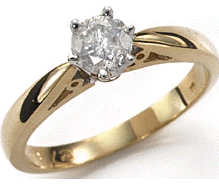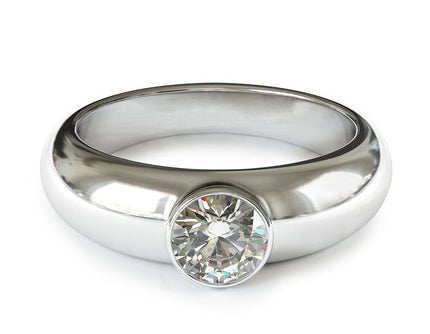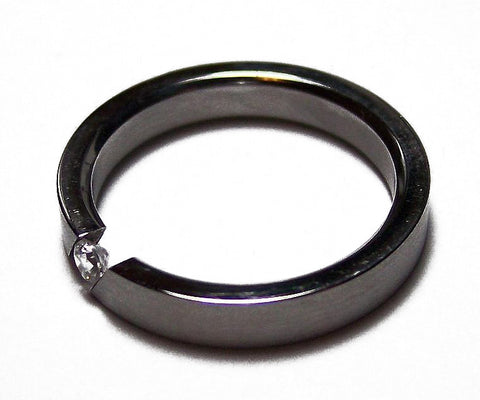Different Jewelry Ring Settings
1. Prong setting

Prong setting refers to the use of metal projections or tines, called prongs, to secure a gemstone to a piece of jewelry. A prong setting is one component of what is known as a head, a claw-shaped type of binding that is welded or soldered to a jewelry item in order to mount a gemstone to the jewelry item. A common setting for diamond engagement rings, the prong setting allows light to strike a gemstone from more angles, increasing its brilliance.
A prong setting offers less protection to the gem than inset mounts. In addition, prongs can snag on clothing or fabric. High quality settings are less likely to snag on clothing, as the prongs are firmly attached to the gem and well finished.
Over time, prongs may get worn out or become loose. Getting the ring checked regularly is a good idea in order to prevent any accidental loss of the mounted gemstone. Some effective ways include using a loupe to check for gaps between prongs and gemstone, listening for sounds made by loose gemstone and taking it to a professional jeweler once every 6 months for checking.
2. Bezel Setting

Bezel setting is a general term for a setting holding the stone in place using a raised surrounding for the stone with a lip encircling and overlapping the edges of the stone, thus holding it in place. Modern bezel settings typically use a band of metal containing a groove and a flange to hold a gemstone in its setting. This was the earliest method of setting gemstones into jewelry. In historic examples, such rings were often made by leaving a hole or slot in the ring with a thin lip which was bent over once the stone was inserted, holding it in place.
In making a typical modern bezel setting, the bezel is shaped into the size and shape of the gem and then soldered into place on the metal of the jewelry. The prepared stone is then placed into the bezel and the metal is pressed down over the edges of stone, locking it into place.
A cabochon stone, a gemstone that is not faceted, usually relies on the shallow angle cut into the side of the stone, which helps the metal to stay in place. With a clear faceted stone, such as a diamond, a shallow groove is cut into the bezel itself. The girdle, or widest part of the gem stone, is placed in the bezel, which is then pushed down over the girdle. The pressure of the bezel over the edge of the diamond keeps it in place.
Bezel settings for diamond rings are also called rub-over settings; they have a diamond completely surrounded by a precious metal band which fastens the diamond securely into place. Bezel settings use a type of elevated collar which wraps the rim of the diamond in a complete metal edging. This type of diamond ring setting is the most secure fastener for the stones. The bezel setting also protects the diamond better than other types of settings, such as the prong setting. A flush setting for diamond rings is a variation on the rub-over or bezel setting. In the flush setting, the stone is placed into an opening and affixed at the bottom of the stone. The top of the diamond is extended above the base.
One advantage of the bezel setting, as compared to the prong setting, is that the diamond is better protected from accidental rubbing or blows, and is less likely to allow the diamond to scratch whatever it may come into contact with. The bezel setting is also more secure, so the diamond is less likely to be dislodged.
3. Tension Setting

A tension setting ring is a type of finger ring that holds a gemstone in place by pressure rather than prongs, a bezel or other mounting. The metal setting is actually spring-loaded to exert pressure onto the gemstone, and tiny etchings or grooves in the metal create a shelf that supports the gemstone's edges. The gemstone appears to be suspended in the air with nothing holding it in place.
Tension settings can not be resized easily, as resizing removes the spring-loading effect. In some designs, they can be resized up or down up to 2 sizes.
Because tension settings place such pressure on the stone, only four types of gemstone can be placed in a tension setting safely: diamonds, rubies, moissanite, and sapphires.
Critics do contend that a stone can potentially be dislodged from a tension setting if it is hit hard enough or if the setting is damaged to the point where its spring loading is compromised.
4. Pavé Setting
Pavé (pronounced “pa-vey”) is a setting that consists of a lot of small gemstones attached to the jewelry by droplets of metal. By closely setting small diamonds together with minimal visibility of the tiny metal beads or prongs holding the stones in place, the surface of the piece with such a setting looks like it has been paved with diamonds or other stones.
This setting is also known as a bead setting. It highlights the center stone, magnifies the ring’s overall brilliance with side stones although highly unlikely, minimal risk of losing side stones exists.
5. Halo Setting
The halo setting refers to the placement of diamonds or other gemstones in a concentric circle or square around a center stone. The halo setting makes the center stone appear larger and it increases the overall sparkle of the ring. Adding a halo of colored gemstones or setting the halo diamonds with a different color metal can make for a contrast in colors. And halos are often paired with pavé bands.
The halo setting enhances overall sparkle due to surrounding stones and securely holds and protects the center stone. However, tiny side stones may become loose and resizing may be difficult depending on the number of side stones.
